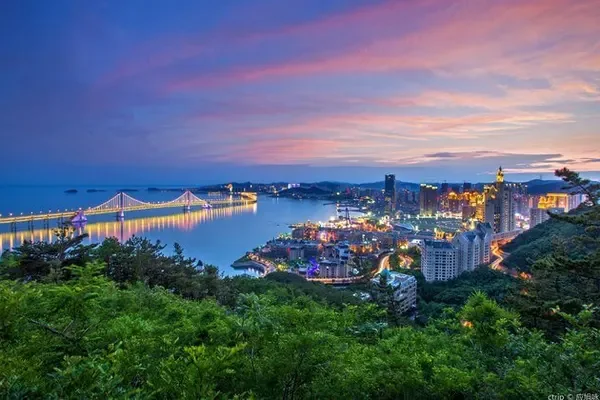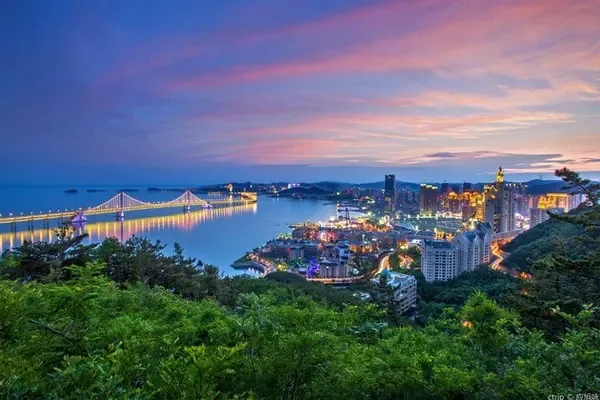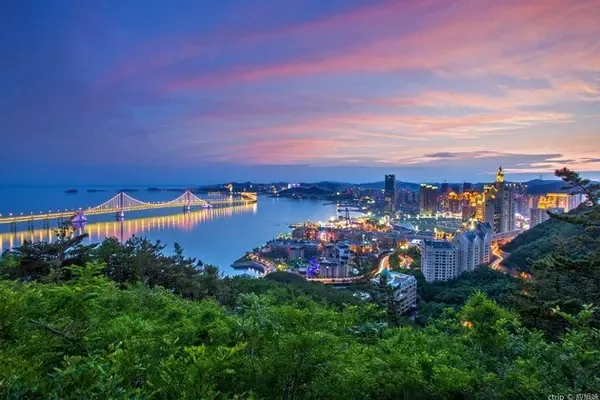Three months have passed since the outbreak of the new crown, and the situation in Beijing has improved in late April, with no new cases for many days. Having nothing to do, I suddenly remembered the place where I jumped in the queue in 1945. It was a small village in the southeast of Beijing, 33km away from Tiananmen Square. After graduating from high school in 1975-76, he joined the team there for 2 years. At that time, male laborers in the village earned 10 cents a day for work, and after a year, they earned 30 cents and 2 cents a day; women earned 8 work cents a day, and male educated youths also earned 8 cents a day. It's less than 10 yuan a month. At the price level at that time, 10 yuan was enough to feed for a month. The villagers still have to wear clothes, raise children, and housing; they don't know what to do when they are sick, and they don't remember who saw the illness. The villagers can only drink porridge at night, and they can't afford it.

This is a satellite photo of the village. I went back once in the winter of 1997. Now 23 years have passed, and I don’t know how many people from the folks back then are still there

Going out at 6:30 in the morning, taking subway line 6, all passengers wear masks

8:12 Transfer at Rongchang East Street Station on Yizhuang Line

Appearance of Beijing subway car

After leaving the city, the subway will go to the ground, on the viaduct

in the subway car

8:26 Tongjinan Station, transfer to bus Xing 58

The interior of the county bus looks like it is very new and very clean

Liangshui River. I don't remember that there was a river here. I checked it on the Internet: "Around 2000, the water quality of Liangshui River was already inferior to the fifth category. When the pollution was serious, there were 469 sewage outlets in the main river branch lines of Beijing, and the Liangshui River accounted for 86. In the past, I often received complaints and reports. Even the police officers patrolling the river have to endure the pungent smell." Now the situation has changed greatly.

This should be near Maju Bridge, within the boundaries of Daxing County

Checked it by hand: Majuqiao second-hand housing, 2 bedrooms, 1 living room, 1 bathroom ·90.91 square meters · north and south · high floor / 6 floors · hardcover · built in 2003
, ¥2.85 million, unit price 31,000 yuan/m2


It should have been wheat fields back then. now only in memory



Industrial parks are starting to appear

It also provides employment opportunities for the surrounding villagers.


Mercedes Benz 4S store?



trees on both sides

back to forest

Dust prevention measures

Stay at Minying Station. Net excerpt: "The Seventy-two Company Camp is the collective name for the villages named after the camp in the Fenghe River Basin in the southeast of Daxing District. At the beginning of Ming Dynasty, the Fanyu Bureau under the jurisdiction of Shanglin Yuanjian was set up in this area. Since then, Shanxi and Shandong provinces have immigrated to the territory under the jurisdiction of the department, making a living by raising and planting. A total of 58 battalions were built, and the villagers called them "Seventy-two Company Battalions"

The clothes of the people who get off the bus are indistinguishable from those in and out of the city.



This forest is purely for greening, and it is estimated that there is no real income









Greenhouse

First, go to Changziying Town to take a look. It was called a commune back then.

The road is quite wide

9:00, it takes 2h30m. The storefront buildings on both sides of the road are similar to those at the provincial and county levels

1975-4-15 It was from this yard that I took the bullock cart sent by the village and started to jump in the queue when I received the village



The pavement houses here should have a monthly rental income of about 100,000 yuan.










dress like this

The town is 7 miles south of the village. go back by car

Get off at Changziying Middle School Station, this is the place where I taught 3 books

A flower shed by the roadside, someone is working

The public toilet next to the station, go in and have a look

It is no different from the toilets in the city. Use it less, be cleaner

Taking pictures here is to record the changes of historical progress

Think about 40 years ago, the per capita GDP of my country and India was the same. Let’s compare it again today. Mr. Jin is still right. Whether a country’s people’s living standards can be improved depends on whether it can industrialize.


The villages on both sides of the road are called Qinshuiying Village

In 1975, the village officials earned more than our village, maybe 1 yuan a day, which was 2-3 times the income of our village

Now the village is a one-story house, and there are no second- and third-story buildings.


The roads on the ground are hardened, and the wind and rain will not affect travel

According to the Chinese custom, there must be couplets at the door of every house. replace once a year

The appearance of the bus in the town. Compare the buses in New Delhi, India's capital

It should be a new car from the village, and it has not been registered yet.


Is this couplet handwritten? educated

If you have money, you like SUVs. When traveling in Germany, 2/3 of the cars there are hatchbacks, saving fuel


The houses of each family are of the same level. Around our big cities, there are no slums and shanty towns

Back then, the house was built with adobe walls, with a layer of red bricks outside. Today it should be all brick walls.



The entrance to the village has been closed, outsiders are not allowed to enter

greening in the village

This is where the commune middle school was located. In the winter at the end of 1975, a female middle school teacher gave birth and temporarily found our village to send someone to take over as a substitute. For the first time, I stepped onto the podium in junior high school. My monthly salary is 35 yuan, 18 yuan is given to the team for exchange points, and the rest is food expenses.
It should be teaching the first year of junior high school, but I can't remember it now. I live in the teacher's dormitory of the school, two people share a room, and a language teacher lives in the same room; he is from a nearby village; I remember he once asked how to solve the problem of factorization, because some students asked him, he is head teacher. He confiscated an endless novel that a student brought to school. I read it. Later I learned that the title of the book was "Laughing Marriage". At that time, the tuition and miscellaneous fees for students were 2 yuan, one semester? A student cannot afford tuition and fees. At that time, farmers could hardly see cash. Eggs are the banknotes of the villagers, and they are bartered.

1976-1-8 When Premier Zhou passed away, I was here

The main building of the school. Net excerpt: In 2017-10, the state stipulated that the salary of teachers was not lower than that of civil servants, and the salary of teachers in the suburbs was lower, which was comparable to that of civil servants in Qingshui Yamen. Teaching high school in Huairou, 6 classes a week, monthly salary ¥2500, good value for money. The elementary school teacher is more than ¥3k. It turns out that our organization has sent someone to an elementary school near my home.

Net excerpt 2018-4-15: In the urban area of Beijing, it is 3000 yuan per month, and in the suburbs of Beijing, middle school teachers who are new graduates can earn 1600 yuan per month. The same is true for high school teachers. Middle school and high school belong to the middle school stage. It mainly depends on how fast you advance. The salaries of first-level middle school teachers and senior middle school teachers are higher, but they are not well received, and the competition is too fierce!

The eldest son camp school is used for primary and junior high schools, with a total of 1,500 students. High school seems to be going to Huangcun, the central town of Daxing District, to study. The doorman said that teachers have a high monthly salary of 5k. The school was closed, and my former substitute teacher was not allowed to visit.

Take another bus and get off at the south side of Zhunao Village. Surrounding factories, or office buildings





9:50 arrived at the south gate of Zhunao Village. What is written on the plaque is: Zhu Huo Village. People in the village liked: agate agate. That is red agate.
There was a male villager sitting under the arbor. I went up to take a look and recognized him as the only high school graduate in the village, surnamed Yuan; but I couldn’t remember his name; the other was a girl, surnamed Wei. I haven't seen him since I left the village. After prompting, he could still call me by my name. He is in good shape, with a straight back. This is the benefit of not smoking. Back then, there were few men in the village who did not smoke.

This is the villager's house in the village, with a second floor.


The building of this color is a family


Downstairs is the shop, upstairs is the living.




This is a one-family house with three floors


Most of the houses in the village were built between 2015 and 2017. The cost is ¥400,000-500,000, with 2-3 floors and a building area of 300-450m2. Up and down water, flush toilet, piped natural gas, internet cable.


This is the outdoor unit of the air conditioner at home. The household heating electricity fee is 10,000 kWh/year x ¥0.1/kWh = ¥1k, and the excess electricity bill is charged at the market price. The village no longer burns firewood and coal, and the government provides subsidies to solve the problem of air pollution in Beijing. There is piped natural gas for cooking.

This is the new home of Jia Ge, the production captain, and it is located at the former site of our educated youth.

The owner, Jia Ge, is at the entrance of the restaurant. He was born in 1952. He is a clean person. The living room is completely white and the windows are clean. The conditions are far beyond my imagination, and I am really happy for them to live such a good life.

The land area of each homestead in the village is: 14m X 20m=280m2. Jia Ge's building is one floor, 14m x 10m=140m2 construction area = usable area. Bright and spacious. 80cmX80cm floor tiles. baseboard.

The one in the red jacket is Captain Jia's wife. People recalled that there were more than 100 people in the village, and there were 11 half-bachelors. During my two years in the village, there was no family with a new wife. Later, bachelors all had wives.

A few acquainted villagers were called. Smoking buddies, still smoking one after another. No one in the village is farming now, and young people are working part-time to earn money.

This is Brother Xiang, who was a clerk at the time and was nearly 70 years old. He was in good health and he did not smoke.

The one in the middle is Brother Sheng, the eldest brother of the team leader. He was an electrician back then, so I might say. The captain's family consists of 5 brothers and 2 sisters.

Originally planned to eat at the restaurant in the village at noon. But the epidemic does not open the door. At noon, I ate 5 cold dishes, 5 hot dishes, pies, dumplings, and white wine at the captain's house.

The rural medical insurance payment is ¥360 per year for adults, ¥60 for children and older men and 55 for women, and the annual payment is halved. 9 years of compulsory education are free. The government provides living expenses for the elderly at ¥800/month. The village committee's income from land industrialization is given to villagers ¥2k/person per year. The rental fee of agricultural cultivated land is ¥200/mu per year, and no one rents it.

A total of 5 villagers were met. I went to each house to see how their living conditions were.



The second family came to Brother Xiang's house. His house is a small building with three floors. There are multiple rental properties. There is no paved room.

Junao Village has 150 household registrations, a monthly income of 700,000 yuan, and a per capita income of ¥4,600, mainly renting out housing (¥700/month) and shops (restaurants: 60,000/month).

The aisle of the ancillary rooms on the first floor outside the building

Brother Xiang's living room is on the third floor, not as big as the captain's house. Brother Sheng’s wife left early, and now his son’s family lives with him, and his daughter-in-law brings us tea and water. The family lives happily.

After coming out of Brother Xiang's house, I went to the third house: Brother Sheng's house. The one who poured water was Mrs. Sheng.


Brother Sheng's kitchen and dining room

Brother Sheng's bathroom, washing machine, flush toilet, everything is available

The fourth one is the exterior facade of Brother Yuan’s house. The restaurant on the first floor is outsourced, with a monthly rental income of 60,000 yuan.

stairwell in building


up to the third floor

The hall outside the living room on the third floor is equivalent to the original patio

Three-story living room door

There are toys for the grandchildren in the living room


On the wall is a group photo of Brother Yuan and Sister-in-law Yuan with her grandchildren

The kitchen is also a modular kitchen cabinet




At 15:00, the last house, the fifth house, is the house of Xiao Fuzi, who was born in 1962 or 1963. The construction area built by his house is the largest, and the homestead is completely covered. The red door is the gate of his house.

In the long corridor in the building, there are rented rooms on the left and right. Provide him with a steady stream of rental income.


This is Xiaofuzi's living room

15:45 Time flies, and I am back on the bus when I came


outside the car

The sky is blue with some clouds

Foreword The blue road sign reads: Sixth Ring Road, Dazhouyi Intersection


This is Beijing's South Sixth Ring Road

8 lanes across







The folks in the village are living a good life, and there is nothing more gratifying than this.
I wish their next generation and the next generation a better life

Get off the bus, it's time to transfer to the subway line


